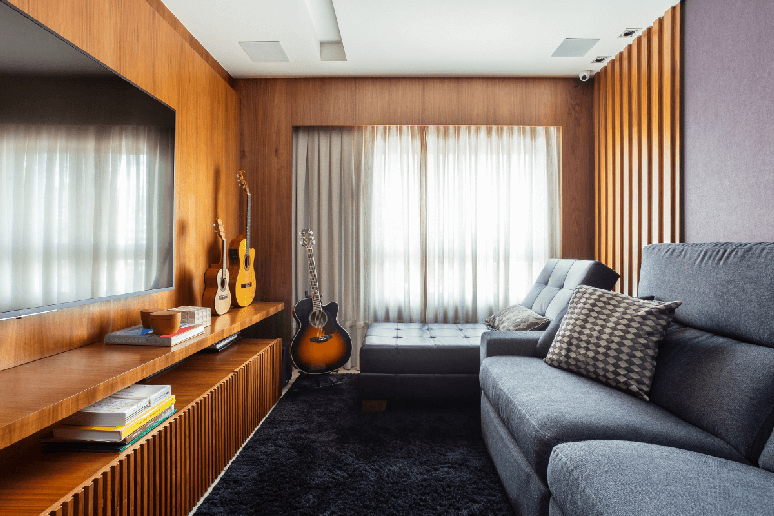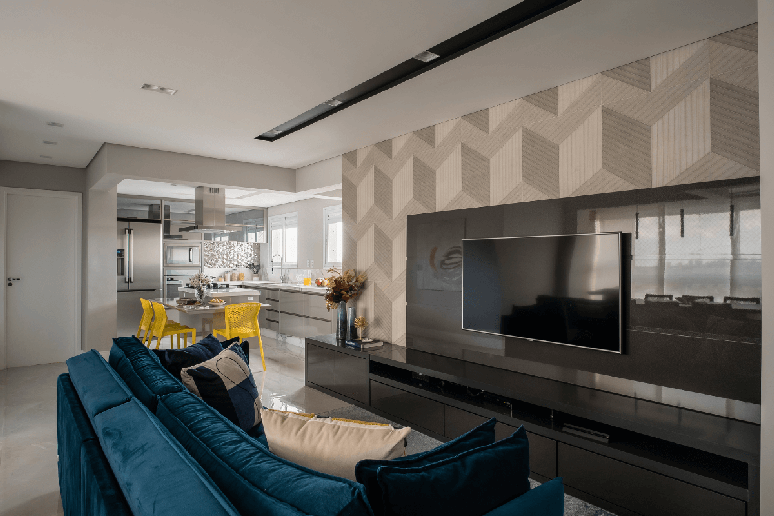Find out how to combine comfort and well-being in a space equipped with screens
Over the years, television has acquired more and more importance, becoming one of the main means of communication, information and entertainment in the modern world. Whether it is checking the programming offered by television channels or the many options available on streaming platforms, streamingthe device is still present in the rooms.
But how to combine comfort and well-being on these occasions? The professionals of PB Arquitetura, Cristiane Schiavoni Arquitetura, Dantas & Passos Arquitetura and Patrícia Penna Arquitetura & Interior Design, list the main suggestions they implement in their projects. Watch!
1. Create a relaxing environment
In many projects, when one of the objectives is the good division of the rooms In your home, creating a TV room becomes essential to separate a specific space dedicated to contemplation and relaxation surrounded by the right equipment.
“The room without TV is more dedicated to the coexistence and aggregation of people and, therefore, highlights a furniture lighter composed of sofas, benches and armchairs. The focus of the TV room is always the screen: so our process is to create an environment designed with the idea of relaxation – from the arrangement of the disposition up to the definition of the furnishings used”, explains Priscila Tressino.
two. Evaluate the size of the TV room
According to professionals, the first step to idealize the TV room is to evaluate the dimensions of the room. Aspects such as the distance between the sofa and the television, the distribution of electrical points, the use of acoustic equipment and special lighting should be taken into account.
To carry out the project, the size of the equipment must be compatible with the area of the environment, both for the sake of harmony between the elements as well as visual comfort. “It makes no sense to buy a huge device if the space is small. It must be compatible and respect a certain distance from other objects”, explains Bernardo Tressino.
3. Calculate the size of the television
According to the architects, simple parameters guide the interior architecture. In the case of height, it is recommended that the TV axis is always in line with the eyes – considering the height of a person in a sitting position, the references are between 1.20 m and 1.30 m from the height. flooring. In terms of minimum and maximum distance, the pair gets the minimum dimensions of 1.5 m and the largest ones of 2.5 m. But how to make this calculation?
Since screens are indicated in inches, you need to convert them to centimeters, where 1 inch equals 2.54 cm. Follow the example for a 50″ TV:
(50*1.5) * 2.54 = 190.5 cm or 1.90 m – in the minimum distance.
(50*2.5) * 2.54 = 317.5 cm or 3.17 m – at maximum distance.

4. Choose comfortable furniture and welcoming
In addition to the television, another fundamental direction concerns the choice of accessories to ensure a comfortable atmosphere. This listing includes a soft and deep sofa, which can also be wider for stretching your legs.
“The cozier they are, the better. Retractable models work well for those with a small room. The version with chaise longue It responds very well to larger proposals, which can be integrated with poufs, used both for sitting and for supporting the popcorn bucket”, advises architect Paula Passos, of Dantas & Passos Arquitetura.
Being a key element of the TV room, it is recommended that the sofa is pleasant to the touch, with a higher backrest and a covering that “hugs” the user. “The Firm sofa is not suitable for this purpose, but for environments designed for the living room,” says architect Danielle.
As regards the colors of the fabrics, the recommendation is to adopt sober tones, which are always easier to match. To complement this, a carpet that is pleasant to the touch, adequate lighting and the inclusion of curtains and shutters blackout for the control of natural light are very welcome in the design of Home theater with a cinematic touch.
5. Choose the right support
In general, racks are often used by people who have many devices connected to the TV. But direct supports on the wall are also commonly seen in masonry structures and drywall – You the panels prove to be effective solutions to better hide the wiring without having to break the wall. Suitable for small apartments and integrated environments, the rotating supports optimize space, allowing a single television to serve two types of environments.
6. Televisions in the rooms
A favorite not only in living rooms, we can often watch television in bedrooms. The ratio between screen size and distance from the bed can be the same as that applied for the TV room, but, in order for the guest to watch while lying down, it must be raised to 1.40 m and 1.50 m high.
Generally a television stand is used. However, to define the appropriate model, it is necessary to analyze its functionality. “The support can be fixed to the wall, articulated, to the ceiling and even automated, depending on the specificity of the project. In cases where it is not present free wall to hang the TV, can be installed hidden, with Flip embedded in the lining, or even inside the wardrobe door itself, in the carpentry project”, explains Priscila Tressino.
7. Use good lighting
Lighting plays a crucial role in creating the ideal atmosphere in a TV room. Choose indirect lighting, such as sconces, floor lamps or LED strips, to avoid reflections on the television screen and create a soft, relaxing atmosphere. Install lights with dimmer offers flexibility to adjust the light intensity as needed, ensuring a comfortable viewing experience at night.
By Emilie Guimarães and Writing EdiCase
Source: Terra
Ben Stock is a lifestyle journalist and author at Gossipify. He writes about topics such as health, wellness, travel, food and home decor. He provides practical advice and inspiration to improve well-being, keeps readers up to date with latest lifestyle news and trends, known for his engaging writing style, in-depth analysis and unique perspectives.









